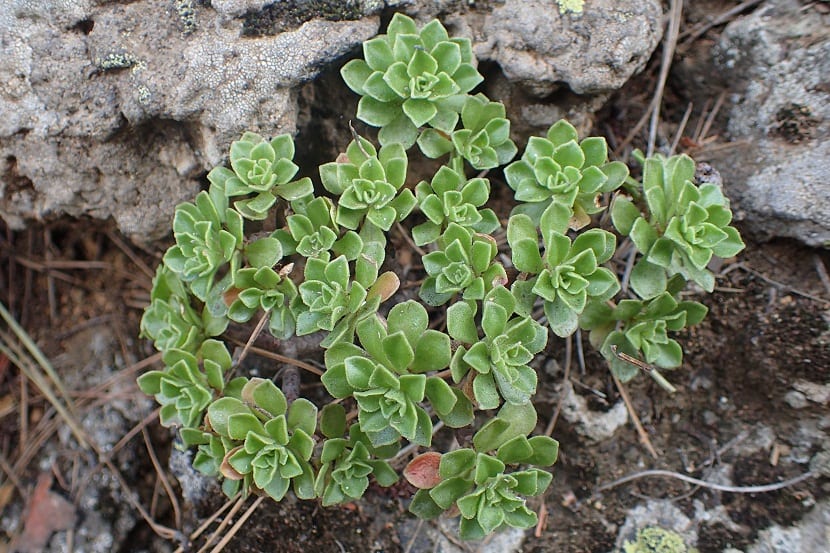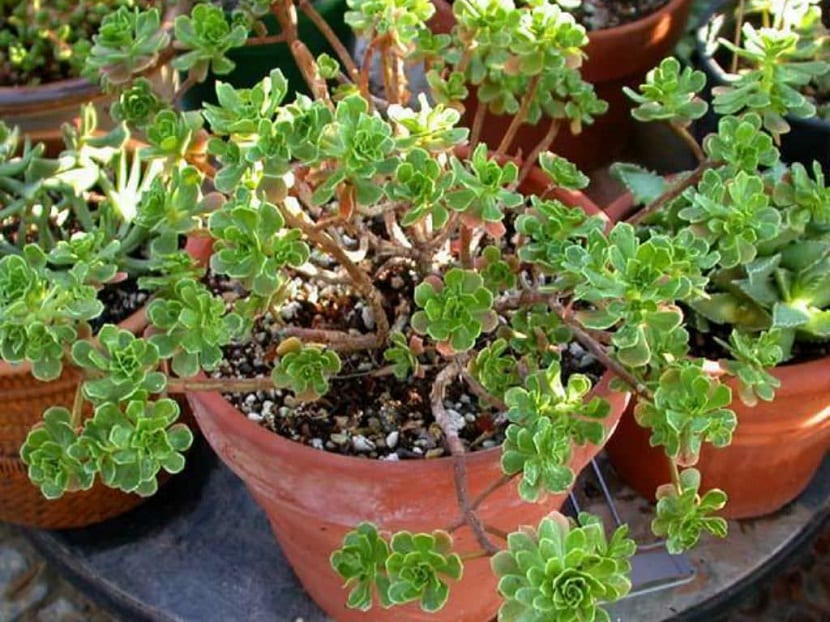
Plant Aeonium spathulatum is flat as a plate and also known as Crag cake, this plant grows in the lava flows located on the island of Tenerife. The flat rosette is only a few centimeters thick and can be found vertically planted as they occur in nature.
This plant has its origin in the Canary IslandsWe can especially locate it in Tenerife, being abundant on the north side, coloring the island with yellowish-green circular spots. It is one of the favorite ornamental plants in gardens and is cultivated worldwide, being one of the most attractive plants, since the beauty of its leaves they make it very visible to the eye. The plant has a high price due to its exotic appearance.
Features

The plant has a very short stem, dense and dressed with old leaves from the base. A simple, sterile plant rosette, where the rosettes are born and develop horizontally, with stems ranging from 10cm that divide the apex into several rosettes, with a diameter of 15cm to 30cm and with dense and flattened leaves throughout the year.
The leaves are interwoven between 8cm and 15cm long and 4cm wide, wedged in shape and attenuated at the base, being wider near the apex, where they are round with a small ridge between the apex of a faint green color.
The flowers has straight stems that grow from the center of the rosette, leafy along the stem.
Its leaves are oval and rhomboid in style to be more exact, they do not branch inside and are sessile. They are faint yellow, with lower flowers about seven millimeters long. Their shapes range from ovate segments four millimeters long.
It is a very particular and showy plant within its group, since its plate shape hugs the ground in the best rosette style. Some are a little different, since not all have this shape.
Sometimes it can be seen as if it were a large green turtle, at other times they grow with multiple branches. The leaves are kept in a continuous pattern, achieving a swirling shape and are usually seen on rocky walls, places where they grow very well.
This plant is the favorite for decorate the gardens, although it thrives inside homes as well.
You can plant it in a small container and you can see it bloom in late spring with its characteristic yellow flowers. Its development can occur from cool temperatures, so in winter you will have to take some precautions and keep it indoors.
Care and cultivation of the Aeonium spathulatum plant
It withstands drought very well, so watering can be carefree every 20 days in the spring, once a month in the fall and rarely in winter.
If the plant is grown outdoors, the autumn rains will suffice. El allowance must be done by those dates, since with compost and a good supply of fertilizer the plants will remain green during the winter.
You have to take care of it from humidity, since can easily rot in winter. They are not usually demanding with the quality of the soil but you should keep it well drained if the terrain is sandy or poor in vegetation.
It is necessary that it is under good lighting, receiving direct sunlight in the morning, during the first hours and during the last hours of the afternoon. You should avoid the midday sun as it can cause leaf and foliage burns.
Reproduction and pruning

The plant does not need pruning, you can cut some flowers to give it a better presence perhaps more compact, that will suffice.
Reproduction can be carried out through the collection of seeds, leaf cuttings and shoots. Those children that the mother plant reproduces are always taken advantage of during flowering next to the stem, although in some cases this will not be the case.
So you will have to choose to use those leaves that are attached to the main stem, near the flower for its propagation. After the plant blooms, the rosette dies like all of its kind.
The substrate is important, so it must have good drainage so that the plant does not rot. You must resort this time to the special substrates for succulents commercially, get some coarse sand or some similar material.
Medicinal properties
This is an easy plant to grow, whether in pots or gardens located on patios or terraces. It offers medicinal advantages, since used to treat burn wounds and with a calming effect on superficial wounds. To achieve this, the leaves must be crushed to remove the extract that will be applied to the affected skin area.
Enjoy this and more plants that you can discover on our blog. Follow us !!